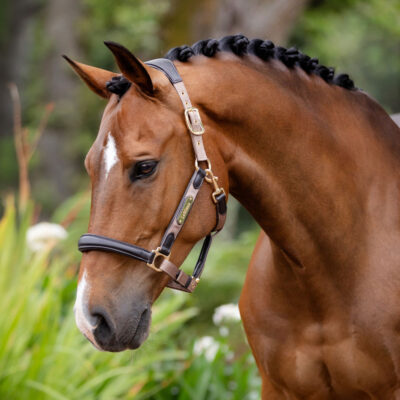Equine Advice
Laminitis In Horses
Laminitis can affect all horses and ponies at any time of the year however it is more common to see new cases in spring/summer.
What is laminitis?
Laminitis is a common, extremely painful, and frequently recurrent condition in horses, ponies, and donkeys. This condition affects the tissues (laminae) bonding the hoof wall to pedal bone in the hoof. This can result in the pedal bone sinking or rotating within the hoof under the weight of the horse. In extreme cases this can result in penetration the sole of the foot by the pedal bone.
What are the signs of laminitis?
Keep an eye out for the following signs of laminitis. Spotting these early allows you to act quickly and hopefully stop it before it takes hold.
- Change in temperament/ behaviour
- Lameness, A shortened stride
- The horse leans back onto its heels to take the weight off the painful toe area
- Reluctant to pick up their feet
- Shifting weight between feet when resting
- Increased digital pulses
- Reluctant to walk on hard/ Stony ground and preferring to walk on soft ground
- Heat at the hoof wall or coronet

What are the causes of laminitis?
So many people ask why did my horse get laminitis and what caused it? Certain circumstances can contribute to the likelihood of your horse developing the condition. Overweight horses or those that have previously suffered with laminitis are more susceptible.
Hormonal conditions
There are two hormonal conditions that are known to be associated with laminitis, Cushing’s disease, and equine metabolic syndrome. Although it is currently unclear how these conditions cause laminitis, both diseases are associated with high levels of insulin in the bloodstream which is known to cause laminitis.
Inflammatory Laminitis
Inflammatory laminitis can be another cause. Inflammatory responses can be triggered by a variety of events or conditions. Such responses can occur after carbohydrate overload – for example, your horse pigging out on spring grass! If you feed concentrates as well as forage, this should be no more than is needed to provide the required energy for your horse. To aid digestion it is advised to spread the daily concentrate ration over at least two meals a day.
Eating a bit too much of the good stuff
Eating a large amount of concentrates in one go can cause an overload in the digestive system with undigested sugar and starch pushed through to the hindgut, where it starts to rapidly break down. This process can damage the gut leading to the absorption of toxins into the bloodstream. It is thought that the toxins may disrupt blood supply to the laminae and increase the risk of laminitis.
Stress Laminitis
Abnormal weight bearing laminitis or stress laminitis can be caused when a horse has a condition or injury where it is unable to put weight on a leg so uses the opposite leg to support their weight. Laminitis can occur in the hoof taking the extra weight.
Can laminitis be prevented?
Prevention is always better than cure!
- Food, restrict the amount of grass eaten rather then the time spent grazing
- Feed forage and feed balancers that are low in starch and sugars.
- Weigh forage to ensure they are getting a suitable amount for their body weight. Soaking hay can also help remove some sugars.
- If you plan to make any changes to feed amount or type this should be done slowly.
- Fitness, regular exercise can help keep your horse maintaining a healthy weight.
- Feet, pick feet out daily and check for heat or bounding digital pulse. Work with your farrier to keep a regular trimming/ shoeing routine.
Treating Laminitis
If you suspect your horse/pony has laminitis then you must call your vet straight away. They can advise you on the first steps and how best to treat. Once diagnosed your vet will put a plan in place on the best treatment. In extreme cases remedial showing may be required, for less severe cases their are many small changes you can make in their daily routine to help.
Should you walk a horse with laminitis?
Walking a horse with laminitis will cause more damage to the hoof. Your vet will assess the pain and severity of the laminitis your horse has and may provide pain relief and sole support. Your vet may also advise box rest for several months.
Which feed can I use?
Pelleted forage balancers are an ideal source of food for laminitis-prone horses as they provide key vitamins, minerals and quality protein appropriate for the horse’s level of work while keeping calorie, starch and sugar intakes low. Remember horses should never be starved as this risks further metabolic complications.
Supplements for Laminitics
Supplements for laminitis can be an advantage for horses and ponies on a calorie-controlled diet to ensure they are not lacking any dietary requirements,
Laminaze is a unique complex of synergistic natural ingredients combining with key gut support, bio-available sulphur and targeted nutrients, in a palatable formula to maintain hoof health and improve their diet and lifestyle. Prebiotics and live probiotic yeast are included for their ability to a stable, healthy gut environment. Naturally sourced antioxidants are present to support the liver. Bio-available sulphur (MSM) is recommended for supporting healthy hoof growth and strong sulphur bonds within the laminae. Laminaze contains all the key nutrients for optimal dietary support, especially around the time of year when spring and autumn flushes of grass occur.

Lamigard TRT Regular Solution delivers a unique approach to the nutritional management and metabolic support for horses and ponies. Lamigard TRT Regular Solution is low in sugar and starch, high fibre, easy to feed and suitable for horses and ponies on very low, or no other concentrate feed.
Benefits of Lamigard Regular Solution?
Melon Pulp is a natural source of key antioxidant enzymes.
Magnesium also plays a key role in helping to support a normal antioxidant and inflammatory response.
Folic Acid plays a key role in nitric oxide generation, which is important for vasodilation -helping to keep blood vessels open in the feet.
Vitamin E is one of the most important antioxidant vitamins to help neutralize damaging free radicals and support the immune system.
Milk Thistle and Marshmallow are important plant-based antioxidant also help to support the liver.


LamiPro is an advanced formula that supports the feeding management of horses. LamiPro helps soothe and support horses at any time or when there is a flush of spring grass. This premium herbal supplement aids digestion and feed utilisation while helping to comfort feet. Can be used long term or short term depending on individual requirements. Suitable for all horses and ponies.
Can my horse have treats?
If you horse has laminitis you will need to avoid feeding any of these:
- apples and apple sauce
- carrots
- watermelon
- flavoured yogurt
- peppermints
Good treats include
- beet pulp with no molasses
- strawberries
- sugar-free candy (avoid anything sweetened with Xylitol)
- hay cubes, broken into pieces
- alfalfa pellets
- Apple Peels
If you prefer to buy store-bought treats, there are a few different options
- contain NO added sugars, molasses, artificial flavours or colourants
- are the safe and healthy way to give your horse or pony a real ‘treat
- ideal for stretching exercises
- perfect crushed to ‘top-dress’ hard feed
- suitable for good doers and “laminitic prone horses and ponies”
Equilblox® Hi-Fibre Blocks are good for horses and ponies that gain weight easily and for those in light to medium work. Hi-Fibre blocks are highly palatable but have low nutritional value making them the perfect treat or complementary feed.
Formulated using 70% dust extracted hay and 30% fibre, Equiblox Hi-Fibre blocks are low in sugar and have no added molasses or additives.
The low nutritional value of Equiblox Hi-Fibre blocks makes them ideal for good doers and laminitis sufferers.
Can I turn my laminitis prone horse or pony out to grass?
The problem with grass is that it is an abundant source of sugar and energy, and it is hard to know how much your horse or pony is consuming. For many leisure horses and ponies, grazing on even average pasture can provide way more energy than they require resulting in weight gain and obesity which predisposes them to laminitis. Then, consuming a lot of sugar from the pasture on a particular day, means a tipping point is reached that results in laminitis.
If you are able to turn out your horse or pony it is vital that you keep them at a healthy bodyweight.
Methods to restrict grass access to help manage bodyweight include the use of a grazing muzzle and strip grazing. Grazing muzzles must be introduced with care to ensure it fits properly, that the horse knows it can eat and drink with the muzzle on and that the horse isn’t being bullied by others in the field.
Sources
Royal veterinary college, British horse society , horseillustrated, dengie





